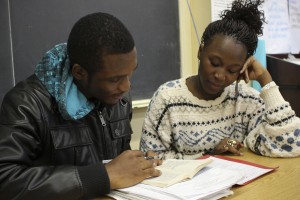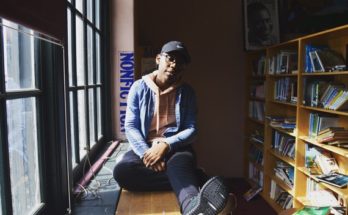Zahra Thiam, 19, sat listening as John Mansaray, 17, read aloud from a book, occasionally interjecting to help him with new words.
“Ain’t. Are not,” she explained to him. “It’s slang, we talk like that too sometimes.”
The two were among about 20 students in a brightly lit classroom at Manhattan International High School on a Monday morning. It was third period and time for their twice-weekly peer tutoring elective. Seniors like Thiam, who moved here from Senegal, volunteer their time to tutor freshman, as well as some sophomores like Mansaray, who is originally from Sierra Leone. Tutors can get internship credits while tutees can earn elective credits. The teacher who initiated the program, Lori Sandler, tries to pair students come from the same country or speak the same first language, so that they can relate better to each other and can translate work if necessary.

The idea had been tossed around among the teaching staff for years, but it was only this year, when there was an opening for a new elective, that Sandler was able to start the class. Most of the students who participated in the first and second quarters are back for more. For newer students, peer tutoring provides some much needed coaching from students who have been through the system before. For seniors, it is a chance to give back to students they can identify with.
“I want to help other students, to give them something that I have, which is a lot of experience,” Thiam said.
The school’s 330 students this year hail from 57 different countries, representing every continent except Australia and Antarctica, and speak 44 different languages, including Urdu, Pashto and Khmer. All of them have been in the U.S. for less than four years and are “English Language Learners” – students who speak a language other than English at home and score below proficient on a test called the Language Assessment Battery-Revised. Many of them, like Thiam and Mansaray, started at the school with only the most basic phrases in their vocabulary.
“I used to get lost on the subway, and I couldn’t read the street names,” Thiam said. “Going to school was really hard.”
Her parents came to this country to find better jobs, and they regularly send money back to their extended family in Senegal. Mansaray’s family, from Sierra Leone, is in a similar situation. His mother came to the U.S. with his brother and sister in 2003 after their father died in Sierra Leone’s civil war. Mansaray came to join them in 2011. His mother still sends money back to his grandmother and other relatives in their home country.
Mansaray learned only rudimentary English in school before coming to the U.S., but speaks five other languages, including Mende and French. He joined the peer tutoring class in the second quarter and said he likes working with Thiam because she is funny.
“She is a good friend,” he said. “Sometimes after doing work we talk and share our common ideas and experiences.”
“From my country to Senegal is not far,” he added.
Anita Sharma, 17, another senior and peer tutor, has had a harder time defining where she is from. Her parents left Bhutan in 1990 for a refugee camp in eastern Nepal, where Sharma was born. She spent nine years in the refugee camp and only started schooling when she was six, learning from other refugees who had left Bhutan before completing high school.
Eventually, her father earned enough to settle the family in a small town in India, before immigrating to the U.S. in June 2009. Sharma started school at Bryant High School in Queens, but left after one week. “I realized that it wasn’t a good fit,” she said, “because my English was not good and if I stayed in this school I would’ve been embarrassed to speak up.” She speaks mostly Nepali and Hindi at home. So she transferred to Manhattan International.
Even though she felt accepted at her new school, it took time to get used to the culture of New York City. “It was very difficult, because I come from a small town,” she said. “In my country you say sorry for big mistakes, here you have to say sorry for every little thing.”
Sharma persevered, and now, as a graduating senior, feels she has been rewarded for her efforts. She applied to 13 universities and so far has been accepted to the University of Pittsburgh and the University of Scranton.
One of the benefits of the program for tutees is getting to interact closely with a student role model. “I often overhear discussions of college and careers as seniors impart valuable advice,” Sandler said. “The seniors [also] benefit in seeing themselves as role models, recognizing how far they’ve come since they themselves were struggling freshmen.”
Tutees in the program are recommended by their teachers based on their need to improve schoolwork as well as their willingness to work hard. Sandler chose the tutors from a pool of seniors who had volunteered based on their interest and ability to work with other people.
Sharma is paired with Cheick Dabre, 15, a student from Burkina-Faso who is repeating his freshman year. He said he is glad for the tutoring class this year because he needs help with his math and other homework.
He came to the U.S. not being able to speak English, and had trouble with the work. Now, he has participated in a school performance and is able to chat with Sharma as a friend.
“If I was to step into his shoes I can feel the same problems he is going through – the difficulties with English,” Sharma said. “When I came to the U.S. I really needed a tutor. I feel like I could’ve done much better than I did.”
She sees it as her responsibility to make sure her tutee does not give up and is trying his best in his work. Last semester, when his report card was sent to his father, who lives in a separate apartment, his father did not show the report to him but told him he was not doing well in his classes. Sharma brought Cheick Dabre to see his teacher in order to request a copy of the report card so that he could see the comments from his teachers and work out which classes he needed to improve in.
Sandler said that the class also helps seniors review concepts. “A recent math project on similar triangles had us all stumped for a while,” she said, “but the freshmen students reviewed their notes, practiced the formulas and theorems, and explained to the seniors, who were then able to help the freshmen apply this information to the project.”
An article published in 2009 in Phi Delta Kappan, a magazine for education policy issues, states that “peer tutoring may not only help increase student mastery of subject knowledge and general learning skills, but also improve student motivation and sense of empowerment as learners”. Despite the known benefits for both tutors and tutees, Sandler said she has not heard of peer tutoring being implemented as a formal class in other schools. But after two quarters, she is optimistic about the progress her students are making. “I wish we had a better way of identifying students who really will work hard, as opposed to those who some days want help with homework and other days would rather just chat,” she said, “but overall I think it is a fantastic opportunity to build connections between generations of students and to support academic and social skill development.”
Sharma seems to feel that connection with Cheick Dabre and is looking forward to working with him more for the rest of the year. “You’re influencing a person to do better and participate in school,” she said.
“I feel kind of proud of him.”




thank you so much Joanna this a great article !!! 🙂